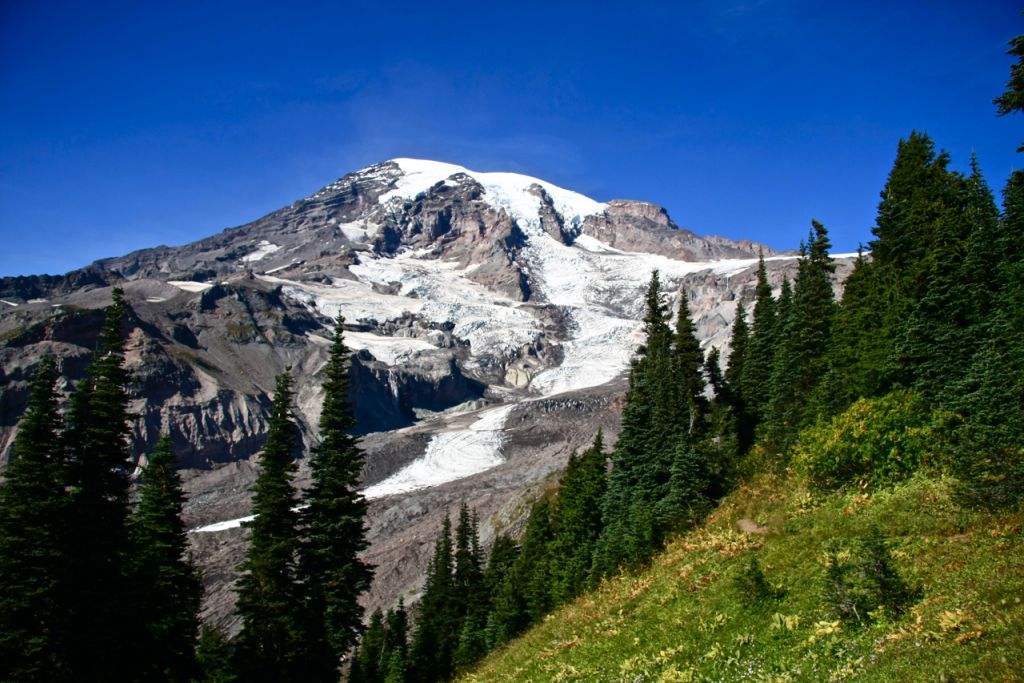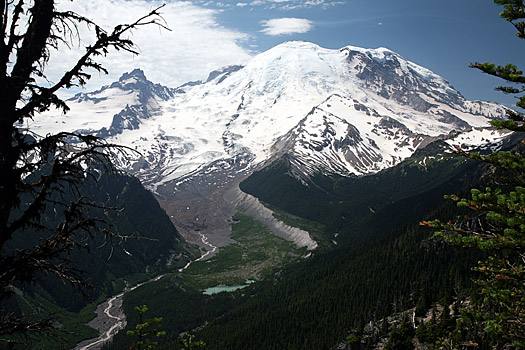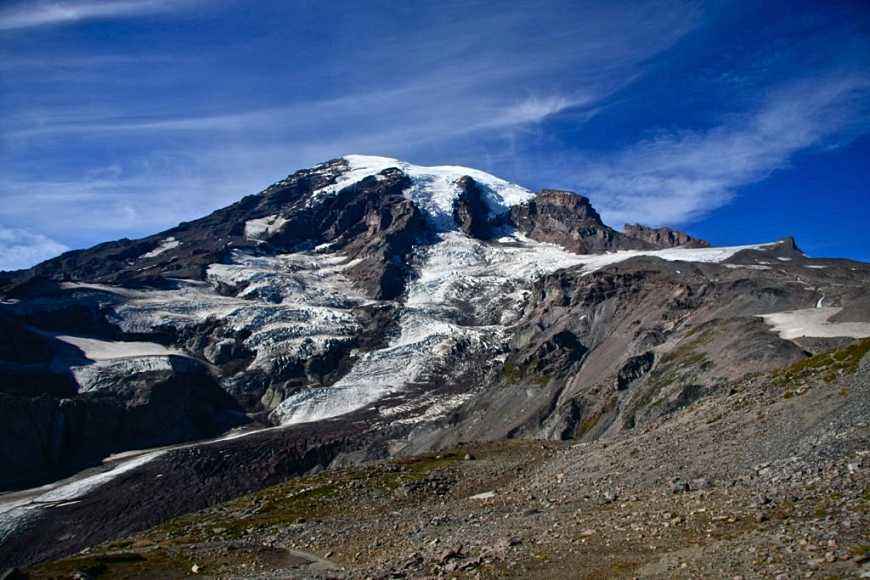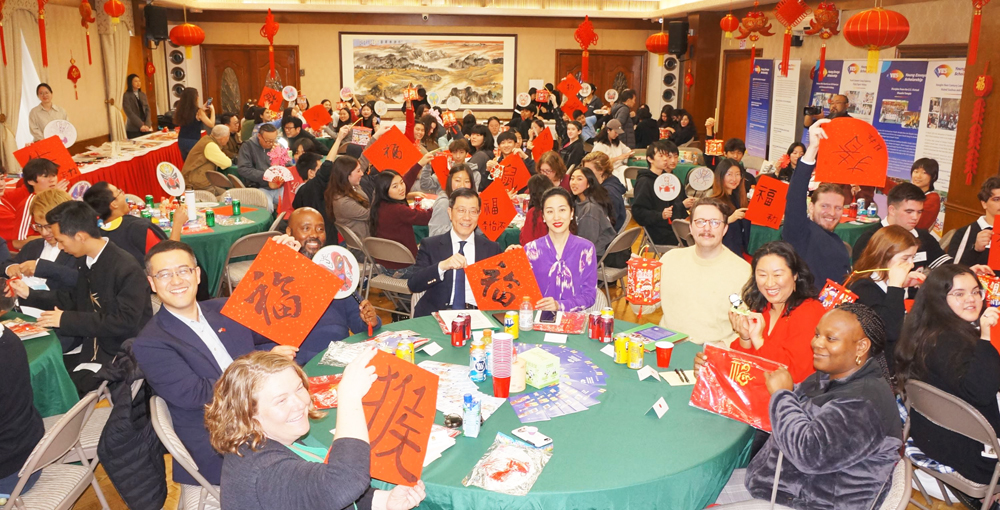2016年12月7日 星期一
Mount Rainier National Park
發佈時間:2017年04月06日 23:51 來源:美新社 评论:0條 點擊:2387次
简单介绍
Two of North America’s mightiest and most explosive volcanoes, slumbering Mount Rainier and smouldering Mount St. Helens, stand side by side in the Cascade Range of volcanic mountains that extends from Canada to Northern California.
Capped by 25 glaciers, 14,410-foot Mount Rainier is the highest and iciest volcano in the lower 48 states, and the tallest mountain in the Northwest. Often shrouded in clouds, its massive snowy dome towers over nearby Seattle and Tacoma, acting as a giant weather gauge. When it is in view, the locals simply say, “the mountain is out”. With over 260 miles of trails, and just a two-hour drive from Seattle, no other mountain invites such convenient exploration for Puget Sound residents.
In summer, a scenic drive from the popular Nisqually entrance of the Mount Rainier National Park winds past waterfalls and old-growth forests to Paradise (5,400 feet), home of the mountain’s most beautiful wildflower meadows and about as close as you can get to a glacier without crampons. To the east, standing at 6,400 feet, the barren Sunrise viewpoint—all tundra, glaciers and mountain goats—offers the biggest mountain views from the highest trails in the park. Heavy snowfall closes most roads in winter, bringing cross-country skiers and snowshoers. Two historic lodges provide dining and accommodation. The bustling 121-room Paradise Inn is the nicer of the two, with incredible mountain views and a mountain man’s Sunday brunch. The smaller and quieter National Park Inn is downslope in woody Longmire, with a front veranda where guests gather to swap trail information.
Only 35 miles south of Mount Rainier as the crow flies is Mount St. Helens (8,363 feet), an active volcano where you can witness the destructive forces of nature close up on a day trip. On May 18, 1980, this once quiet, beautifully symmetrical mountain, with a fishing resort tucked away on Spirit Lake, was devastated by a huge eruption of superheated steam. The volcano’s top 1,300 feet were obliterated in a cataclysmic blast—with the equivalent force of 21,000 atomic bombs—that flattened 150 square miles of forests, triggered landslides and boiling mudflows, and fumed a 15-mile-high cloud of ash and rock into the air at speeds of 500 miles an hour. In the end, 59 people were killed in the blast, and a pall of volcanic ash drifted as far east as Saskatchewan. In 2004, a smaller explosion reawakened the possibility of another major eruption, and geologists keep a close eye on growing domes inside the crater.
Scenic Truman Highway (State Route 504) climbs to Johnston Ridge Observatory, just five miles shy of ground zero, with a spectacular view of the sometimes-smoking crater. In early summer, a carpet of pink and violet flowers spreads across the desolate blast zone—life is returning to the once-devastated and still scarred landscape.
地址



Two of North America’s mightiest and most explosive volcanoes, slumbering Mount Rainier and smouldering Mount St. Helens, stand side by side in the Cascade Range of volcanic mountains that extends from Canada to Northern California.
Capped by 25 glaciers, 14,410-foot Mount Rainier is the highest and iciest volcano in the lower 48 states, and the tallest mountain in the Northwest. Often shrouded in clouds, its massive snowy dome towers over nearby Seattle and Tacoma, acting as a giant weather gauge. When it is in view, the locals simply say, “the mountain is out”. With over 260 miles of trails, and just a two-hour drive from Seattle, no other mountain invites such convenient exploration for Puget Sound residents.
In summer, a scenic drive from the popular Nisqually entrance of the Mount Rainier National Park winds past waterfalls and old-growth forests to Paradise (5,400 feet), home of the mountain’s most beautiful wildflower meadows and about as close as you can get to a glacier without crampons. To the east, standing at 6,400 feet, the barren Sunrise viewpoint—all tundra, glaciers and mountain goats—offers the biggest mountain views from the highest trails in the park. Heavy snowfall closes most roads in winter, bringing cross-country skiers and snowshoers. Two historic lodges provide dining and accommodation. The bustling 121-room Paradise Inn is the nicer of the two, with incredible mountain views and a mountain man’s Sunday brunch. The smaller and quieter National Park Inn is downslope in woody Longmire, with a front veranda where guests gather to swap trail information.
Only 35 miles south of Mount Rainier as the crow flies is Mount St. Helens (8,363 feet), an active volcano where you can witness the destructive forces of nature close up on a day trip. On May 18, 1980, this once quiet, beautifully symmetrical mountain, with a fishing resort tucked away on Spirit Lake, was devastated by a huge eruption of superheated steam. The volcano’s top 1,300 feet were obliterated in a cataclysmic blast—with the equivalent force of 21,000 atomic bombs—that flattened 150 square miles of forests, triggered landslides and boiling mudflows, and fumed a 15-mile-high cloud of ash and rock into the air at speeds of 500 miles an hour. In the end, 59 people were killed in the blast, and a pall of volcanic ash drifted as far east as Saskatchewan. In 2004, a smaller explosion reawakened the possibility of another major eruption, and geologists keep a close eye on growing domes inside the crater.
Scenic Truman Highway (State Route 504) climbs to Johnston Ridge Observatory, just five miles shy of ground zero, with a spectacular view of the sometimes-smoking crater. In early summer, a carpet of pink and violet flowers spreads across the desolate blast zone—life is returning to the once-devastated and still scarred landscape.
地址
(46.8500000, -121.7500000)
电话:
(360) 569-2211



上一篇:
Raging Waters San Jose04月06日 23:53
下一篇:
海象滩 - Elephant Seal Beach04月06日 23:48
發表評論 已有0 條評論
本周熱門點擊
























